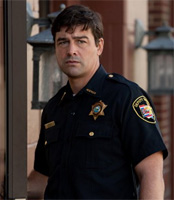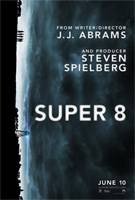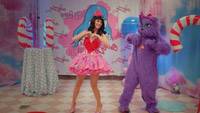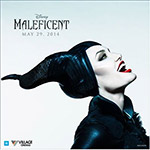Elle Fanning 20th Century Women
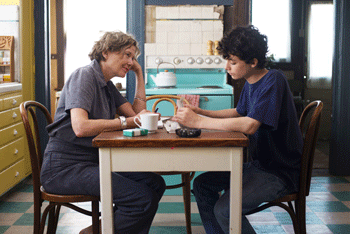
Elle Fanning 20th Century Women
Cast: Elle Fanning, Greta Gerwig, Annette Bening
Director: Mike Mills
Genre: Comedy, Drama
Running Time: 119 minutes
Synopsis: With 20th Century Women, acclaimed filmmaker Mike Mills (the Academy Award®- winning Beginners) brings us a richly multi-layered, funny, heart-stirring celebration of the complexities of women, family, time and the connections we search for our whole lives. It is a film that keeps redefining itself as it goes along, shifting with its characters as they navigate the pivotal summer of 1979.
Set in Santa Barbara, the film follows Dorothea Fields (Annette Bening), a determined single mother in her mid-50s who is raising her adolescent son, Jamie (newcomer Lucas Jade Zumann, in a breakout performance), at a moment brimming with cultural change and rebellion. Dorothea enlists the help of two younger women in Jamie's upbringing – Abbie (Greta Gerwig), a free-spirited punk artist living as a boarder in the Fields' home, and Julie (Elle Fanning), a savvy and provocative teenage neighbour.
Mills expertly draws on the warmth and passion embodied in memories of his past, while recreating the urgency and energy of three generations in the throes of momentous transition.
Bening gives one of her very best performances as Dorothea, conveying with subtle yet tremendous emotional power both her unconditional love for her son and her increasing bewilderment about the world she is watching him enter. Gerwig, Fanning and Billy Crudup all do outstanding work, creating complex, unique characters who each contribute in crucial ways to Jamie's upbringing.
20th Century Women is a poignant love letter to the people who raise us – and the times that form us – as this makeshift family forges transient yet momentous connections that will mystify, haunt and inspire them for the rest of their lives.
20th Century Women
Release Date: June 1st, 2017
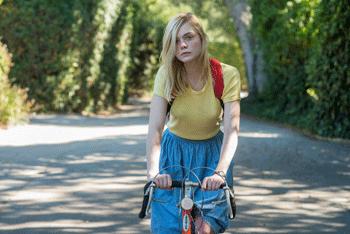 About The Production
About The Production
'The future always comes too fast and in the wrong order."– Alvin Toffler, Future Shock
1979: a moment of pivotal transition. It is Jimmy Carter's last year in the White House. Iran's Islamic Revolution has begun, as has the hostage crisis at the American Embassy.
For the first time, Americans feel a loss of control over the growing thirst for oil, as dependence on the Middle East turns into long gas lines and a much talked-about 'energy crisis" – all of which reverses the fate of the gas-guzzler car and Detroit's power. The country is in a recession; Carter delivers a 'Crisis in Confidence" speech; Brenda Ann Spencer is the first modern teen school shooter; Three Mile Island has America's first major nuclear accident; therapy makes its way to the suburbs; Apple Computer goes public; Margaret Thatcher is elected Prime Minister; and the counterculture seems to be losing its relevance.
In a sense it is the moment when all the issues, concerns, technologies and cultural forces that we experience as 'contemporary" start to concretise. As director Mike Mills says: 'The late 70s are kind of the beginning of -now' …and yet the late 70s are a completely different world from what will come just around the corner – with all the changes that follow Reagan, the 80s desire for wealth, the tragedies of AIDS and the impacts of the internet, 9-11, as well as unchecked economic disparity. That's why 20th Century Women can feel like an elegy for a time and an innocence we can never return to."
Meanwhile, in sunny Santa Barbara, single mum and Bohemian land-lady Dorothea (Annette Bening) is facing her own shifting 20th Century reality – a series of personal upheavals as she entreats her household's women to help her son Jamie navigate the world … only to see him introduced to the rebellious ecstasy of punk rock, the perilous lures of art and romance, and the fragility of life. This is all the territory of Mike Mills' intimate, comedic yet beguilingly epic drama 20th Century Women – which is set at the juncture between social history's dizzying transitions and everyday life. His story is at once a textured tale of love, regret and momentary connection in one family; an ode to the strength of women through the generations; and a culturally electric study of how the lives we lead in the moment become, at shocking speed, the eras we look back on in wonder from the future.
The film's tightly-knit ensemble – who form a non-traditional family circle – is led by fourtime Academy Award® nominee Bening in her most emotionally exposed role to date as a guarded woman nevertheless driven to lend those who need it a safe haven. As Dorothea, Bening is at once a mother navigating blinding change in her own inimitable way and a potent reminder of how the children of the Depression became the parents of the 70s, whose children created the utterly altered society we live in now. Says Mills: 'I wanted to tell a story about the personal moments of grace within all that disruption and to look at how intimate mysteries twine with huge social forces."
The film is equally a love letter to Mills' mother and to the women who raised him. Mills says: 'In a sense, this is the story of the Greatest Generation meeting Generation X – my mom being born in the 20's and me from the late 60's. On one level, the film is a love story between a mother and son, a love story that is very deep and unique, yet may never bring them the solidity they both yearn. The film tries to capture those transient moments where you feel true connection with a loved one, these little moments of grace, of understanding and connection, which are more fragile and transitory than we're taught – but when they happen, even fleetingly, they are truly a lot."
After Beginners
'I told him life was very big, and unknown; there were animals and trees and sky and cities, music, movies and stars and colours out here, outside the box. He'd kiss, have friends, fall in love, have his own children."
Mike Mill's previous film, Beginners (for which Christopher Plummer won an Oscar® and Golden Globe), took its inspiration from Mills' father and his revelation that, at the age of 75, he was coming fully out of the closet. 20th Century Women is inspired by Mill's far closer relationship with his mother. They share fundamental similarities – both are constructed atop an autobiographical foundation; layered with humour, cultural artefacts and a fascination with near-connections and fleeting time; as well as cut through with Mills' kinetic, collage-like visuals. But the two films are also quite different. 20th Century Women, as the title suggests, is very much about the female experience of America as the last century sped towards the finish line in crisis mode.
For Mills, relating personal stories to shared historical narratives has been a theme throughout all the mediums in which he works. Perhaps typical of his own generation – the one known simply by an ambiguous X, floating as it does in the void between Baby Boomers and Millennials – Mills has defied easy definitions. He's always had a multidisciplinary career as an artist, graphic designer and filmmaker. He has made album covers for The Beastie Boys and Sonic Youth; worked on music videos for Air, Pulp and Yoko Ono; and exhibited his art internationally, at museums including MOCA and in the permanent collection of SFMOMA. He approaches his work as an integrated practice – it all shares a way of showing how intimate moments of love and identity fit like puzzle pieces into the larger maps of culture, society and time... or as the feminist phrase has it, how 'the personal is political."
His earliest short films exposed his twin passions for both the funny, real textures of everyday life and the fast-running currents of modern culture. Deformer (2000) entered the world of L.A.-based pro skateboarder and artist Ed Templeton; while Paperboys (2001) explored the dying art of the adolescent newspaper deliverer. His first feature adapted Walter Kirn's novel Thumbsucker (2005) into a fresh take on how angst and inadequacy are part of the fabric of human lives at any age. This was followed by the documentary, Does Your Soul Have a Cold? (2007), about the coming of anti-depressants to Japan. Then, in 2010, the breakout success of Beginners established Mills as a mainstream cinematic voice.
But with 20th Century Women, Mills faced his biggest challenge so far. When a man writes a woman it doesn't always go deep. But Mills relied both on his own experiences as an adolescent surrounded and forged by fascinating women as well as interviews and research to craft resonant voices for the film's 3 different generations of women in contrasting phases of life: Depression-raised working mum Dorothea, Baby Boomer artist Abbie and Gen X teen Julie.
'I was raised by a very strong woman – and this story comes from that very real person and out of a very real place," Mills notes. 'My father was present and yet not present during my childhood. Most of my childhood was spent with my mom and my two sisters. Since then I've always gravitated toward women – and I guess I realised early on that trying to figure out these women around me was a form of survival. I was always studying them, trying to learn from them, even when they were inscrutable."
The impossibility of teenaged Jamie ever fully grasping his mother is set off against his clear love and respect for how she conducts her life as a single mom and mysterious force unto herself – which became not only a writing challenge but a central tension inside the film. Mills continues: 'Writing in women's voices feels very natural to me, but writing Dorothea was not easy, especially because my mother was and will always partially be a deep mystery to me. It was not just a matter of trying to comprehend being a 55-year-old mother who had a child at 40, but also what it was like to be born in the 20s and then confront the intense social changes of the 70s. That involved both research and personal conjecture."
Some details of Dorothea's persona Mills borrowed directly from his mother. 'She did want to be a pilot, she did work at an all-male company and she did love old movies, especially anything with Bogart," the writer/director notes. The latter became one of several routes in for Mills, always in love with movies. If punk was the screaming emanation of a generation for whom conventional heroes no longer existed, he saw that Bogart had been the last of the heroes who had fit into a new, post-Depression, post-World-Wars world – rueful, mischievously caustic and futilely noble in a world rife with uncertainty.
Says Mills: 'I watched a lot of films from that era and the witty dialogue between men and women also became an influence. So many of that era's movies are subversively funny and that helped me to understand Dorothea better. I realised she didn't so much want to fall in love with Bogart as she wished to be him. A mantra for writing Dorothea became: What would Bogart do in this situation?"
Creating Abbie, the 20-something punk artist who fled her creative dreams in New York when she received a cancer diagnosis, also drew on a mix of Mills' personal experience with artist friends, as well as research into life as a young cancer survivor. The stark realities of mortality and fertility are as much a part of the mix of 20th Century Woman as punk exuberance. 'A loved one of mine had a similar story with cervical cancer, and I interviewed her at length while researching the script," Mills notes.
The persona of the film's youngest but certainly no less complex female character, Julie, draws on an amalgamation of girls Mills hung out with in high school, several of whom he interviewed. 'I worked journalistically to understand these characters," Mills comments. But that journalistic approach also merged with elements that hold a more mysterious attraction to our imaginations – memory, comedy and especially the workings of time on the human heart. Mills observes that many of his cinematic influences explore how time exerts itself on lives and loves. They include Alain Resnais, the French New Wave filmmaker who simulated the non-linear essence of remembrance in such films as The War Is Over, Hiroshima Mon Amour and Muriel; Istvan Szabo's Love Film, in which a man reflects back on a haunting adolescent love in the years between World War II and the dropping of the Iron Curtain; and Fellini, who Mills often watched on his iPad before shooting.
'Fellini is the master of giving personal experience a cinematic scale," Mills explains. Still, 20th Century Women is concerned not just with the passage of time but more so with its escalating speed in the last several decades. Observes Annette Bening: 'Change is something we've always dealt with as humans – but it's the rate of change since the 20th Century that is so new. It's so fast. And part of what I love about this story and why it appealed to me so much is that I was a young girl in 1979 California, so I relate to the girls in the movie – yet, I also feel I have been all of these characters at one time or in one way or another. I think we're just at the point now where we can look back on the latter part of the 20th Century with any perspective – and Mike in his incredible talent is tapping into that."
Beyond cinema, the cultural influences that infuse 20th Century Women run deep – vinyl albums, best-selling books, political anxiety, shared television moments and a variety of paraphernalia line the film wall to wall. They span not just 1979, but the cultural fabric of Dorothea's life too. 'You can almost sum up the film as being the trajectory from -As Time Goes By' to the Buzzcocks,'" Mills muses.
That epic sense of how overlapping layers of moments and obsessions make up personal lives is the film's distinctive territory – as is another cultural signifier of the early 21st Century: the circular and self-referential. There is an uncanny feeling watching the film that one is watching a writer/director looking back on how he became the artist driven to look back by making the very film we are watching.
Notes Billy Crudup: 'We all have childhoods that are the foundations of who we are, but what Mike does in this film is draw not only on his experiences but also on the evolution of how he's come to see those experiences, years later. He's showing you how the kid he was became the filmmaker who developed the aesthetic with which he is telling you the story. I think that's why it is such a universal experience. Mike crafts a terrifically charming story onto which we can each project our own lives."
The film's self-reflexiveness comes markedly into play when, mid-way into the narrative, Dorothea informs the audience of her impending future, bending time and our perspective of everything to come in the story (and reminding us that we ourselves are watching from the future), but in her direct way, sans overt mysticism. The choice came to Mills suddenly, organically, and he followed it. 'It suited Dorothea as a character. Dorothea is always somewhat elusive, a bit like a trickster. And the future is so unpredictable to us, we're always getting it wrong. But she gives us this fleeting glimpse."
Dorothea
'Let's go out tonight. I'd like to see this modern world."
'Dorothea is 55 and looks like Amelia Earhart," Mike Mills wrote of his film's main character. In the film, her son Jamie further describes his mother by her stark contradictions: she writes down her stocks every morning, smokes Salems because they're healthier, wears Birkenstocks because they're contemporary, reads Watership Down, then carves rabbits out of wood and never dates a man for long.
Each of those details was braided into Annette Bening's deeply personal creation of the character. Yet, what the four-time Oscar®-nominated actress (The Kids Are Alright, Being Julia, American Beauty, Grifters) did with them seemed to transcend the sum of those parts, says Mills.
'Like my mother was, Annette is a little secretive. She is her own mystery and what she does is very magical. She comes from such strong craft that she deeply understands the structure of a scene. But what she is able to do is to then to leap out from that position of craft and become fully alive and unknowing in the moment," he observes. 'It's my favourite thing when actors jump past their preparation and try to fly, and Annette loves to do that. We both were often surprised by what she did on camera."
He adds: 'We talked a lot about my mother, but Annette doesn't re-create her so much as layer her details into something original. The Dorothea you see on screen is built from Annette's timing, intuition, intelligence and humour. She creates a lived experience of a woman in her circumstances."
Bening had an immediate reaction to Dorothea's richly human incongruities. 'I enjoy women with contradictions – and we all have them," she laughs. 'So often in storytelling women are two-dimensional stereotypes, but Mike writes about women as fullfleshed, complicated human beings."
As she dove in, Bening carved her own road between Mills' memories and her performance.
'Dorothea's not a direct characterisation of his mother," she notes, 'but part of the process was hearing Mike's tales of his mother, experiencing his memories, looking at photos and really feeling what this time period in his life meant to him. In good acting there is always a funny alchemy of you being fully and naturally yourself while also exploring the character. And I think that becomes an easier process when a story is so good that you feel you are both looking inwards and serving something larger than you."
Because 20th Century Women is in part a love letter to the mothers we love but can never fully know, Bening knew she had to walk a precarious line. 'It was tricky because Mike's story asks people to love Dorothea but it also acknowledges that she can be prickly and stand offish, especially with her son. That's a fine balance – figuring out how to let people inside her but also see there is a part of her that is and always will be inaccessible to Jamie. To some degree, I left it to Mike to reconcile those things in the storytelling, while my job was to play each moment as truthfully as I could," says Bening.
Further inspiration came to Bening from Dorothea's heroine, Amelia Earhart, the pioneering pilot who defied conventional femininity in the 20s and 30s. She inspired Dorothea's unfussy take on personal style. 'When you look at photos of Amelia, it's a whole different way of thinking about women and beauty," she notes. 'It's different from what we favour culturally right now, with all that cultivated, overdone makeup and quest for ageless perfection. Dorothea wouldn't have been into that; she didn't dwell in a world where that was important. It's another of her contradictions. She is, in 1979, very much a woman of the moment, an independent woman, but she's also from another time with different mores."
Those different mores both ground Dorothea and make her wonder about the future, especially in a house where she sees young women leading lifestyles which she couldn't have imagined at their ages. 'There's a freedom that Abbie and Julie have and I think Dorothea sees that and thinks, -wow, what would it have been like to grow up like that?' Yet, she's lived enough to know there's a certain cost to freedom and it isn't necessarily easier being a young woman in 1979," says Bening, 'just different."
Dorothea's greatest attraction in the film is a momentary one – to her taciturn, ex-hippy handyman William, played by Billy Crudup, an attraction Bening intuitively fathomed. 'I really felt I know who William was and I had a lot of affection for the character before we even started. But the way Billy played him without any artifice and with such interesting choices opened it up even more," she says.
Bening continues: 'I think Dorothea is surprised by her feelings towards William, but she's not willing to compromise who she is to take things further – and I don't know if that's good or bad, but it's very clearly who she is. That's something I think you realise as you get older: we all do the best we can but we come to know where we won't compromise even when there's an obvious cost. I liked getting the chance to play a character who sees that. The one thing Dorothea isn't willing to give up is her individuality – whatever else, she won't let go of her integrity."
At one point, Bening asked to wear a piece of Mills' mother jewellery and she dons a silver bracelet throughout the film. 'It was a bit like a talisman," Mills muses. 'I often think of filmmaking as a bit of a spiritual magic trick, so I find it's a good idea to invite the Muses in to help you."
Bening agrees that such objects carry a mysterious weight. 'What was important is that it meant so much to Mike," she says. 'We all know the most banal objects to someone else can be the thing that gets you right in the heart. The objects Mike uses weren't so important themselves, but it's the totality of all they represent, and that's what allows you to leap from the personal into this kind of story."
Abbie
'I'm going to need a story."
Renting a room in Dorothea's house is a young woman Dorothea engages to help guide Jamie: Abbie, who is at once riotously creative, deeply self-aware and trying to find her way after cancer altered her grasp on the future. Greta Gerwig, the actress, writer and director known for her work in Noah Baumbach's Greenberg, Frances Ha and Mistress America, took the role and ran with it.
'At first, it was difficult to think of someone I thought could pull this role off," Mike Mills admits, 'but then Greta quickly came to mind. She understands the art world and she herself made the journey from Sacramento to New York to pursue experimental theatre. But she also really connected with the sadder, hidden parts of Abbie. She felt the weight of Abbie so strongly, she'd cry even as we were just talking about the character. She is funny and vibrant like Abbie, but reaches deep emotions."
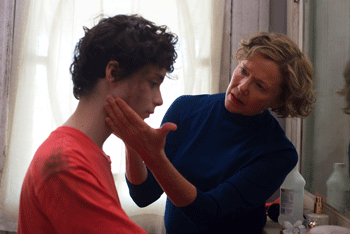 Gerwig's affinity for the role began as soon as she read the script. 'I felt this immediate, strong link with Abbie," she recalls. 'I know what it's like to be from California but wanting to be part of the New York art world. Abbie's spirit and her darkness and her edginess feels like it doesn't quite have a slot to fit into in California, so she escaped it, but then she had to go back, and that's a tough thing to do."
Gerwig's affinity for the role began as soon as she read the script. 'I felt this immediate, strong link with Abbie," she recalls. 'I know what it's like to be from California but wanting to be part of the New York art world. Abbie's spirit and her darkness and her edginess feels like it doesn't quite have a slot to fit into in California, so she escaped it, but then she had to go back, and that's a tough thing to do."
While Gerwig came to New York for the theatre scene, she loved having the opportunity to immerse herself in Abbie's world: the iconically gritty, downtown New York art and photography scene of the 70s. The era was a last hurrah of a different New York – loft rents were still low, crime was still high and there was a raw sharpness to an explosion of bodyoriented performance art, photorealism, feminist wall-hangings, graffiti paintings, outsider galleries and ecological works. 'The chance to explore this through Abbie's lens was exciting," says Gerwig. 'Dance, art, music, photography and street culture were colliding in Soho at that time and it must have been amazing for someone like Abbie." Gerwig dove into the work of photographer Cindy Sherman, whose performance-style selfportraits unravelled the feminine tropes of 20th Century pop culture. She also probed the work of feminist artist Barbara Kruger who layered photography with bold statements ('your body is a battleground") as well as punk poet/artist Patti Smith and others who explored the crisscrossed terrains of female body image and objectification. 'It was a time when women photographers were looking at self-representation and the idea of the gaze," notes Gerwig. 'What I took from these artists is a mix of sexuality, power and toughness and a willingness to let that all burn in their work."
Mills and Gerwig discussed many influences for the role – including seductively androgynous Talking Heads' bassist Tina Weymouth and Debbie Harry, the Blondie singer who became a darker twist on the pin-up girl. Remarks Gerwig: 'I think what was so sexy about the punk girls is they were saying -I'm hot, but it's not for you.' Their hotness wasn't coquettish. It took on a dangerous streak. And I think that punk aesthetic that your feelings are something bigger than your skills really spoke to Abbie."
Diving in further, Gerwig carried a vintage camera around for months and had a rule that she couldn't listen to any music recorded past 1978. Later, she dyed her hair with the same Manic Panic temporary hair colour that came out in 1977, catering to the first female punks. Fierce and seductive as Abbie may be, she is contrastingly in an acutely vulnerable state, recovering from a DES-caused cancer that is changing her notions of sex and motherhood. Gerwig spoke with survivors of cervical cancer diagnoses and read books focused on women and cancer to understand more. 'These women were very generous to share their stories," she says. 'One thing I realised is that 1979 was a very different time to have cancer. There was no Live Strong movement, no real survivor pride. Dealing with cancer was private and dark and dirty. The culture around it has really changed." Gerwig latched onto Abbie's contrasts of light and dark, high and low. 'What I love is that wildness and maternalism go together in her; they aren't exclusive ideas," she points out.
'That's what's so beautiful about Mike's writing: he puts together things that maybe don't seem to go together yet he sees that they do, because that's how life really is." Contrasts also come out strongly in Abbie's friendship with Dorothea. 'Abbie adores and nearly worships Dorothea," says Gerwig. 'To her, Dorothea is truly independent and she's succeeded in creating her own little universe with its own rules. Abbie feels so dead-ended when she returns to California, and I think finding Dorothea is a wormhole back to something meaningful."
When she decides to seduce William, Abbie finds a different kind of solace, even if fleeting. Says Gerwig of their initially awkward but ultimately fulfilling connection: 'At first, Abbie wants William to pretend to be other be people because being herself right now is just too painful. She's in such a self-conscious place. But William's greatest gift to her is that just wants to make love to her as who she is. She's not really meant to be with William but what they have is something very beautiful."
Julie
'It's not even about being happy, it's about strength and your durability against the other emotions."
While Julie doesn't actually live in Dorothea's house, she is nevertheless a secret boarder there, often sneaking through the window to join her best friend Jamie in bed late at night. For Jamie, Julie is everything he would ever want in a soulmate… if only she would let him fall in love with her completely. A child of sexual freedom yet aware of its burdens, she is also the daughter of a therapist accustomed to being prodded for her feelings, but that too, she yearns to escape.
'Julie was partly a way for me to explore the difference between someone who comes from the modern world of therapy and Dorothea who comes from a time when you were expected to hide things about yourself away," says Mills. 'But Julie's normalness and competency is revealed to really just be a mask on top of someone who is a very unusual individual."
To play her, he chose Elle Fanning, the 17-year-old star recently seen in We Bought a Zoo and Maleficent. Mills felt she paralleled the character in several implicit ways. 'Elle is such a smart, grounded and fully present person that you feel she is connected to some deep river of intuition. She has an immense talent but also a direct link to what is true emotionally far beyond her years. She's similar to Annette in her approach – in that she's always very conscious of scene structure and, at the same time, she's able to inhabit her character as if there's no camera at all. Her moment-to-moment acting is something pure. She also really understood that, savvy as Julie is, she's still a kid."
Fanning leapt from a place of instant kinship with Julie. 'She has so many sides to her – she wants to be a woman but she doesn't really know how and at the same time she's doing her best to fake it really well," Fanning observes. 'I think she wants to be seen as a kind of precocious intellectual – a Jodie Foster type – and she has some of those qualities, but she also is kind of unwashed and uncertain and a secret chain smoker. Mike and I talked a lot about the girls she is based on and the idea was to get behind the surface of these girls who can seem so alluring."
Growing up in group therapy, Julie is no stranger to the endless search for elusive happiness, or for cracking secrets. 'It's an interesting split that she has because I think all kids like to keep secrets, but Julie is supposed to tell all so that she can be analysed," notes Fanning. 'She handles that by turning it around and analysing others, particularly Jamie. She was raised to believe it's perfectly normal to butt into people's most private feelings."
Julie's self-awareness is cold comfort when it comes to her unfolding sexuality. Despite living in an era when the rules are fewer, and before AIDS, Julie doesn't quite know how to steer through it all, choosing to make a sharp separation between the physical, the emotional and the sheer thrill of attracting boys. 'To her, sex is not love," Fanning observes. 'She doesn't really know what love is – but she has a fantasy of it that I think she uses to protect herself. As much as she cares for Jamie, she doesn't want to ruin their friendship with sex. It scares her in a way because she's so afraid of losing their friendship."
Fanning's preparation for travelling back to 1979 involved lots of retro-cultural immersion. On the music front, she laughs: 'Mike had me listen to tons of Fleetwood Mac. That was Julie's music." She also dove into Julie's favourite book: 'The Road Less Travelled" by M. Scott Peck, the iconic pop psychology read that begins with the words 'life is difficult" and set many a 70s youth off on one quest for personal growth or another. Recalls Fanning: 'Mike gave me homework: he asked me to go through it carefully and find the passages I thought Julie would be most interested in. It was a great process."
Julie also uses a new device that was changing women's realities in 1979: the brand new home pregnancy test. Though first developed in the 60s, the tests did not become commercially available in the U.S. until 1977, with a first ad announcing 'a private little revolution that any woman can easily buy." Mills says: 'The home pregnancy test is an epically meaningful bit of history. There's a theme in the movie of birth and how nothing is easy around that subject. Abbie can't have children. Julie's sister was born with cerebral palsy, and Julie fears being pregnant. Reproduction is such a huge part of women's narratives and that is equally true whether you're looking at it historically, politically or personally."
Later, Julie is asked by Dorothea to become one of Jamie's surrogate parental figures – a role she relishes. Fanning was excited to reunite with Annette Bening, having collaborated earlier in Sally Potter's Ginger & Rosa. 'Having worked with Annette helped," she says, 'because Julie isn't at all intimidated by Dorothea and so I couldn't be with Annette. Annette so raises the bar, she makes everyone stand a little straighter. At the same time, she's a wonderful person and a brilliant actor. Her birthday scene is the first time I've ever been moved to tears by someone's performance while I was in the scene."
Fanning especially anticipated their biggest scene together – when Dorothea corners Julie in the car only to find herself interrogated about her love life. 'I knew that was going to be a really special scene and luckily it came near the end of shooting, so I was feeling really comfortable. Annette is such a strong person but Julie's not scared of Dorothea and this is her chance to face Dorothea one-on-one."
Says Bening: 'Elle is such a unique person but I love that the girl she created in Julie is so not Elle. Julie is such a badass, but at the same time she breaks your heart, because she's really searching for something. I find her shocking and funny and touching. I also don't feel like I've seen the particular kind of relationship she and Dorothea have before. They both are kind of prickly, yet they're both admiring of each other and yet they are also wary of each other."
With Greta Gerwig, Fanning struck a deep connection. 'We got really close during production," she reveals. 'I find her to be such a fascinating human being – so creative and cool – which was great, because I think that's exactly how Julie feels about Abbie." Although Julie has only limited encounters with William, Fanning perceives an unspoken link there. 'He's sort of an older male version of Julie. Like her, he doesn't really know what love is and they're both kind of lost souls at this point in their lives. Billy was so great, he really inspired me."
Fanning found she had an affinity for Mills' layered directorial style, which builds connections piece-by-piece. She recalls: 'He had mini-sessions between me and Lucas, me and Greta, me and Annette. It was all very psychological and there were a lot of exercises where we shared stories of things we did as kids – and that added up to bringing us very close. I felt so safe with Mike to be open about personal things – maybe partly because Mike would share stories too and it felt like we were just friends talking. He still has that essence of being a kid where he would get so excited about stuff and was so passionate about this film being a love letter to his mum. I think you can feel his heartbeat in the film."
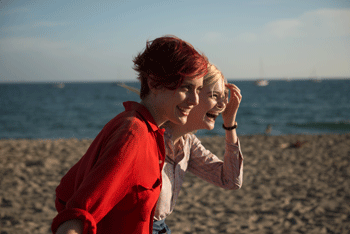 William
William
'I always think it's gonna mean more than it does, but then it doesn't, you think the next one's gonna mean more, or maybe the next one."
The only major adult male character in 20th Century Women is William, the handyman who is both renovating Dorothea's house and becoming a fixture within it. While Dorothea might initially see William as a potential substitute father for Jamie, Jamie shows no signs of bonding with him. Instead, William becomes the object onto whom the household's many women project a variety of desires.
For Mike Mills, William comes out of a very specific kind of mould: the post-hippie struggling to find a workable path on the cusp of the 80s. 'William is one of those men who started out following the narrative of the 60s counterculture but that wasn't quite enough to create an entire life and by the late 70s, he's kind of lost his through-line," comments Mills. 'It's a time of men in flux. There were no more Bogarts in 1979. Even President Carter was the most interior, vulnerable President we'd ever had."
Taking a role at once comedic and tender is Tony Award-winning stage and screen star Billy Crudup, recently seen in the Oscar®-winning Spotlight and beloved for his role as a rock guitarist in Cameron Crowe's Almost Famous. Mills says of Crudup: 'Not every actor could put himself in the positions William finds himself in, but Billy is rare in his willingness to go anywhere. He plays William as this gentle, sweet man who is also a bit lost and inarticulate. Billy put all these stutters and pauses into his dialogue, accentuating the idea of the silent man everyone projects things onto – and he moves slowly, as if through a haze.
He is passive, but also is kind of an accelerant to everyone in the house." In creative collusion with Mills, Crudup developed William's many nuances. 'Mike had a lot of ideas about William but then we worked together to create a reality," says Crudup. 'He told me there was always a guy in his mother's house who was a handyman or construction worker, but in the film, William is the one Dorothea identifies as her chosen male role model for Jamie. She has just one objective: to help her son navigate a treacherous time in his life while navigating a treacherous time in America."
The explicit underpinnings of the character – as a reflection of changing masculine mores – made making William real even more of a challenge. 'William is meant to represent something, but that is never an easy thing to play," notes Crudup. 'So specificity was very important to make him a real person and Mike and I spent a lot of time just mapping out his history. We talked a lot about why this guy likes having his life complicated by all these mysterious, elegant, complex women."
As the cameras rolled, Crudup grew even more entranced by William. 'I never wanted to stop playing him, and that's not always the case," he confesses. 'Sometimes even if you adore a character it becomes tedious at some point, but not William. I think it's because he's so located in the present moment and without direction, so every day was a bit surprising. I was also very curious about the pain that runs beneath his sweetness, and about his lost appetite for ambition. He's lost conventional ambition but he hasn't given up. He's still trying to love and be loved, and that's what is so touching about him."
William's mix of impassiveness and compassion added to the allure. 'Beneath William's charm something is screaming that he hopes someone will come along and help define his identity for him. But at the same time, that makes him quite willing to try out just about any situation that presents itself," Crudup says. 'He'll go into any room in the house under any circumstance, just to see what will happen."
That includes Dorothea's room. 'He finds her contrasts of fragility and strength intoxicating," says Crudup. 'Also she's a woman who likes to get down and dirty and fix things and that's a big turn on for him. And I think she's also the only woman who has ever really celebrated him for who he is."
Crudup notes that, even as William is roaming Dorothea's house, the mood of the nation is mirroring his search for identity. 'Mike could not have picked a more intriguing time to explore the sexual and personal politics in Dorothea's house," he says. 'I don't think it can be underestimated how the national identity crisis of that time shaped the culture. It sent a lot of people into tailspin."
With Abbie, who is in a personal tailspin, William also plays a catalytic role, allowing himself to be taken into a hazardous sexual situation as her first lover since cancer treatment.
'Abbie projects onto him that he is the ideal person to be her chaperone back into the land of the living, and then he begins to see himself that way, ignoring all the reasons that they're not a couple to be," comments Crudup.
One of many pleasures of the production for Crudup was the chance to work with his hands, William's refuge in a world that will quickly become increasingly technological. 'I've never really worked on cars so I spent a few days just learning about engines and then I worked with some carpenters and with a potter," Crudup explains. 'It was like a mini-tutorial and I love that about making movies."
Jamie
'Please excuse Jamie from school this morning, he was doing volunteer work for the Sandinistas."
The audience's eyes and ears into the world of Dorothea's house are those of her son Jamie – who affords us the witnessing power of the adolescent in the midst of that moment when you are more expressive, more in doubt and more in love with life than perhaps any other juncture in life. Like many young men, Jamie is auditioning identities for himself, but unlike many, he is doing it with women of different ages and perspectives, including the mother he both adores and can't even hope to comprehend.
Mike Mills cast teenaged newcomer Lucas Jade Zumann in a role that hangs a mirror before his own youth. Still, Mills was looking for someone unalike. 'I'm least interested in my own -selfness,'" he says. 'So I like that Lucas doesn't look like me at all. Instead, he occupies my situation at the time – being a skater, a punk, having all these women in my life – in a way that isn't really me. Lucas is oddly cerebral for a 14-year-old, so you really buy that he's this very observational young man, a kid with a very real desire to know these women around him. He portrays Jamie as neither macho, nor a nerd, nor broken." Zumann was fascinated by those very same circumstances. 'Jamie's in this moment of trying to become a man – but without any male role models," he notes. 'Instead, he's living in a house full of women who are trying to be his role models and he's trying to figure out manhood from that."
While his life is nothing like Jamie's and Zumann was never into punk or reading feminist tomes, he related immediately to the struggle for identity. 'What's so great about Mike's writing is that it's so personal and every character is so relatable and as real as a screen character can possibly be," he says.
That said, Zumann was determined to merge some of Mills into his performance. 'When he was talking to us as a cast, I was listening to what he was saying but another part of me was also studying him and taking notes," he laughs. 'I do hope there's some of Mike that comes through in Jamie. He's not the same as Jamie and we talked about those differences but I wanted to do my best to create this amazing, creative person as a young man."
The one place Zumann's real life connects with Jamie's is in their mutual love of skateboarding. This gave him insight into why it is Jamie's chosen form of domestic escape. 'In the rehearsals, Mike had Greta as Abbie ask me as Jamie why I like skateboarding and I remember I said -I feel like I'm in a little bubble on this moving piece of wood – just passing by all these people without any judgment,'" he recalls. 'And I think that is true for both of us."
To transport Zumann back to an era long before he was born, Mills sent him a giant box of 70s cultural artefacts. Zumann took the opportunity to submerge himself. 'I spent a week in bed reading The Cultural Dictionary of Punk, while watching 70s documentaries and punk videos," he muses. He also consulted his grandmother, who came of age in the 70s. 'It was great to talk to someone who actually lived through all this and could give me a sense of what it all meant to people."
The greatest challenge was yet to come – finding an equal parts awkward but loving rapport with Bening. That came easier than Zumann expected. 'I remember looking at this amazing cast list and thinking, how will I live up to this? But with me and Annette, we just clicked and it felt like mother and son," he recalls. 'Right away, she started calling me -kid' and I called her -lady.' Ironically, I had a more functional mother-and-son relationship with Annette than Jamie does in the story – but that is what the movie is about and we found those moments of connection that hold Jamie and Dorothea together."
Says Bening: 'Lucas is such a lovely guy, and I was so grateful that we were able to have such an open and curious relationship. He's a very unusual teenager and that's part of why Mike cast him as Jamie. I learned a lot from him because he still has the very pure approach that we all try to maintain."
Zumann put a lot of thought into what Jamie wants from his mother, even if it will always be just out of his reach. He was especially cognizant of their deep generation gap.
'Like any kid does, he wants a meaningful relationship with his mom that isn't uncomfortable, but that doesn't come naturally to them. They grew up in vastly different times and worlds. At times, it's like they're speaking different languages. But what's great to me is that I think while some in the audience will relate to Dorothea and others to Jamie – no matter which one you relate to more strongly, Mike sheds some light on both sides."
He also loved the storyline between Jamie and Julie, which isn't at all your typical teen romance, even if Jamie would rather otherwise. Zumann says of Jamie's attraction: 'I think Jamie sees Julie as being closer to a complete person than he is and he envies that. What's funny is that Dorothea wants him to learn from Julie and he really does. She teaches him a lot about women and himself. At the same time, she's clearly not an adult no matter how mature she pretends to be – and Elle was great at revealing that."
Some of Zumann's purest scenes are silent but kinetic – as when he literally dances as if no one is watching with Abbie. It was a fascinating experience for the young actor.
'One smart thing Mike did was never let me watch the monitor," he laughs. 'He understood I had to avoid being self-conscious as much as possible, though it wasn't possible! And I tried to channel some childhood memories – I had one of listening to Billy Idol while I was dancing around my bedroom, playing air guitar and I remembered that feeling of freedom, of being alone and as if there was nothing else in the world that mattered."
Ultimately, Zumann says his whole world shifted during production, but on a subtle, internal level. He summarises: 'I think doing this film has really brought me into a different place of knowing and self-reflection and thinking about life, and I hope it will do the same thing for people my age in the sense that maybe they won't feel so alone and they'll accept certain things about being who they are."
The Punk Realm
'They don't know this is the end of punk. They don't know that Reagan's coming and Bush and Clinton…It's impossible to imagine HIV and AIDS, and the personal computer, what will happen with skateboard tricks, your own life, the internet."
By 1979, the punk rock subculture – which some defined as much a state of mind as an anarchic, hugely expressive mode of music, fashion, literature and art – had emerged from the underground and was finally hitting the U.S. suburbs. Just as the world seemed to be creaking on the cusp of shattering changes, popular music was undergoing its first real revolt since the advent of rock n' roll.
Though its roots are debated, punk first developed into a thriving subculture in the mid 70s on both sides of the pond – in New York's grittiest clubs and London's poorest streets – as disillusioned kids expressed their boredom and frustration with 60s counterculture by ripping their antecedents to shreds, replacing paeans to peace and love with headlong leaps into rage, pandemonium and having 'no future."
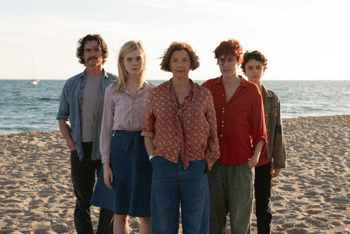 Furiously opposed to the rise of consumption-as-lifestyle, full of do-it-yourself verve, based on vitality over virtuosity, defiantly declaring otherness and sometimes radically political, punk became an anchor for many, particularly outsiders of one type or another across the globe. California punk started becoming its own regional scene in the late 70s, spreading out from L.A. and Orange County. As so-called 'hardcore" and 'surf punk" bands emerged, including the emblematic Black Flag in 1979 – rivalries broke out between those adhering to the artier bands and those drawn to the abrasive newcomers.
Furiously opposed to the rise of consumption-as-lifestyle, full of do-it-yourself verve, based on vitality over virtuosity, defiantly declaring otherness and sometimes radically political, punk became an anchor for many, particularly outsiders of one type or another across the globe. California punk started becoming its own regional scene in the late 70s, spreading out from L.A. and Orange County. As so-called 'hardcore" and 'surf punk" bands emerged, including the emblematic Black Flag in 1979 – rivalries broke out between those adhering to the artier bands and those drawn to the abrasive newcomers.
For Mike Mills, growing up in sleepy Santa Barbara, the discovery of punk was both a revelation and an electric emotional conduit. 'For me the energy of punk was something euphoric," he recalls. 'It felt like running towards freedom with your eyes closed. I remember almost overnight going from Elton John to The Clash. The culture hadn't really offered a lot of emotional bandwidth until I discovered this music. I wanted some of that energy, that verve, to be at the core of the film."
Mills also remembers the enmities between fans of different bands that marked the punk culture in California. 'I was actually called -art fag,'" he remembers, a term thrown at Jamie in the film for liking the cerebral, art-school-trained Talking Heads. 'I was called that for liking the Talking Heads, Bauhaus and Joy Division, but it really was a time when you could quite literally get in a fight for liking the wrong band."
All of that is inexplicable to Dorothea, for whom music came from a more soothing, romantic tradition. Abbie, on the other hand, uses music as an education for Jamie, introducing him to the more obscure and feminine sides of punk, including such all-female British bands as The Raincoats and Siouxsie and the Banshees – who were forging a sub-subculture that had its own rules.
The film's aesthetic draws from punk's passion for the collage, for the tearing apart and reassembling of familiar elements from our world into something full of connotations and hidden meanings. Mills scoured the photographic record of the period for the documentary stills seen in the film – ranging from Joe Strummer to L.A. punk scene veteran Darby Crash. Mills sums up: 'Music is a character in 20th Century Women and there are many different kinds of music in the film – but to me it is in essence a punk movie, both in the way it moves and in its human contradictions."
The Malaise Speech
'Human identity is no longer defined by what one does, but by what one owns. But we've discovered that owning things and consuming things does not satisfy our longing for meaning." – Jimmy Carter
In the middle of 20th Century Women, the characters engage in a late 20th Century rite: gathering -round the TV set to watch Jimmy Carter's speech. The specific speech – known later as 'the malaise speech" or 'the crisis of confidence speech" – was delivered on July 15, 1979, towards the end of Carter's uneasy term in office.
In an unprecedented and to many shocking display of Presidential candidness, Carter lamented a country too focused on 'self-indulgence and consumption," assessed his faults as President, and noted he was worried that, in the face of crisis, the nation had lost 'a unity of purpose." The speech actually raised Carter's approval ratings, but his firing of much of his Cabinet a few days once again sparked the perception that his administration was crashing.
For Mike Mills, the Malaise Speech was a fitting moment for the members of Dorothea's household to bond. 'That speech seemed to mirror a particular moment of anxiety, of feeling that the way life has gone until now is not going to continue. And it comes at a time when Dorothea and Jamie are both feeling at the end of their ropes," he points out. 'I liked the idea of laying the characters' emotional reality up against this document of history. One of the things I also love about that speech is that it seems wildly impossible now – but also prescient in so many ways we can only see from this time period."
Santa Barbara
'Get out of this town before you end up working in a sunglasses shop."
The disparate elements within 20th Century Women – punk culture, skate culture, the fading counter-culture, Dorothea's mix of Bohemianism and Classicism, and especially the laid-back vibes of Santa Barbara and Dorothea's rambling old house – mix together to become the film's distinctive look.
Mike Mills notes that Santa Barbara was a different place in 1979 than it is now. It was still a relatively affluent coastal beach town with almost impossibly perfect weather, but it wasn't the exclusive enclave of 2016. 'When I grew up in Santa Barbara it was before there was even the word Yuppie and people wore their money very differently. Oprah wasn't living there. It felt sleepy and forgotten, more like -Grey Gardens.' You had long-established families running out of money and there was a lot more dilapidation and run-downness. It mirrors the story of the country, really. Santa Barbara then had a lot more mixing of the middle class and the wealthier, whereas now you're either super fancy or poor." Mills worked closely with his carefully assembled crew – including director of photography Sean Porter (Kumiko, The Treasure Hunter, The Green Room), production designer Chris Jones (Henry's Crime), costume designer Jennifer Johnson (Beginners) and Oscar®- nominated editor Leslie Jones (Rules Don't Apply, The Master, The Thin Red Line) – to create a lived-in feel to a movie that drops the audience directly into its characters' lives in mid-commotion, even while lightly playing with time.
Aiming for a punkishly hypnotic pace and vitality – but with meticulously created frames – Mills talked with Sean Porter about using lots of camera movement. 'We laid a ton of track through the house so the camera could really move and did a lot of complicated set-ups," Mills notes. The movement is not only physical but metaphysical. 'I like films that are structured by surprise and I like to use dislocation, where you move quickly from funny to sad, from static moments to the unexpected," he says.
Porter and Mills also chose to shoot in wide format and pour lots of organic light through the film. Says Mills: 'I love how natural light looks cinematically – it's beautiful and I find it creates a very real space. It also impacts the actors in their naturalism. It's a real part of the gestalt of this film."
Designer Jones found Dorothea's house – a veritable character in the film – in the West Adams section of Los Angeles because houses like that are now rare finds in Santa Barbara. Mills sought a house with an old school grandeur but also in the deconstructed throes of mid-renovation. 'We had a lot of discussion about the house – how big it should be, how much it is supposed to feel like it is falling around the people inside it, and how it should flow," recalls Jones. 'But the most important thing about the house is that it had to have a richness to its bones – all those cracks and flaws that make it feel warm and full of history. Once we found that, we set about giving each individual room its character's style."
One word recurs over and over when Jones talks about the design approach: layering. This is what gives Dorothea's house its inviting ambience – layers of details from each of the residents and their entire life's obsessions. Part of that layering involved sprinkling items from Mills' own history, as well as a few one might spy in his previous film Beginners. 'You see my parents' bedspread in Dorothea's room, as well as my parents' chairs and some art.
It's subtle but imbues the film with a bit of that inexplicable magic of origins," says Mills. For Jones, this was both a boon and a challenge. 'Since this film is very much from inside Mike's head, the challenge for me was in really trying to reach inside that head and pull out not just a memory but a reality out of it. Of course, there is also the fact that Mike himself is a graphic designer. He is obsessed with colours and also with how objects become icons in our lives – a theme in the film."
Then there was the matter of how to approach a period that has become renown for kitschy cinematic treatments. Mills was in search of something more unfiltered, more idiosyncratic, more specific to his characters. 'I didn't want us to wear the 70s on our sleeves," says Mills. 'I always tried to pick the choice that was less showy in its period qualities. And a lot of what you see in the house is from before the 70s since it is full of Dorothea's prior history."
Adds Jones: 'The look is not typical, because this is not so much -the 70s' as it is Mike's personal experience of the 70s. We did a lot of work together. Our set decorator and I would show Mike item after item from prop houses and catalogues and there was often more -no' than -yes,' but that was OK with us, because over time we were really able to distil it all down to what felt exactly right to him."
The layout of the house is introduced when Julie arrives for the first time. 'It was a really smart thing that Mike and Sean Porter did to show Julie moving through the house because it gives you the map of the film's landscape," says Jones. 'One nice thing about the house we used is that you can see from one room into another and we enhanced that with a lot of sheer textures and plants."
As a poster-maker himself, Mills had a lot of interest in what appears on the walls not only in the house but other locales. Julie's workplace is lined with Maxfield Parrish posters, whose whimsically colourful prints decorated the walls of American homes throughout the 20th Century. The Art Nouveau posters of Czech artist Alphonse Mucha make an appearance, as do vibrant, Marimekko-style prints. 'These are all reminders in a way of pre-digital, pre- internet life," says Mills.
For Dorothea's room, Jones focused on Mid-Century pieces from the 60s and early 70s, and soft, grey tones. To re-create the architectural firm where she worked as a draftsman, Jones utilised an old hospital, filling clinically minimalist rooms with drafting desks from another era.
All of this bluntly contrasts with Abbie and Jamie's rooms. '1979 was a big year of change but I think it was also a turning point as the older generation was forced to see the world their children live in in a different way. It was a bit of a shot to the heart," says Jones. So in Abbie's room especially you see a lot of those punk influences, with those New Wave vermilions and teal blues and colours that begin to look like the 80s." In addition, Jones created the photographs that are meant to be Abbie's experiments. 'We spent a whole afternoon just shooting objects in Abbie's style," he muses.
Jamie's room is more blank – and not just because he belongs, as the 1977 punk song by Richard Hell and the Voidoids had it, to the 'blank generation." Explains Jones: 'Jamie likes the streamlined punk aesthetic but he also can't do much with his room, because nothing in that house is permanent, and he never knows what his mother's next renovation project might be. So he just has a mattress on the floor, which further echoes the idea that he is so impressionable – that he's still learning how to be who he is. I think that's also more true of boy's rooms. Girls are more mature and they know their interests. But boys are kind of in this void until something energetic and exciting like punk and girls come into their lives."
It is Julie who brings colour into Jamie's room, via the work of costume designer Jennifer Johnson. 'Whenever Julie comes into the scene, she is always dressed in these very bold, primary colours," Jones notes. 'She brings a whole different vision of life into Jamie's room." Jones was especially inspired to create the Santa Barbara punk club – having also been initiated into punk at a young age. 'I was weaned in the 80s on post-punk and had the same experience of discovering it while living in a small town – where it wasn't so much about rebelling as about learning to think in a new way about the world," say Jones. 'In 1979, punk clubs were mostly basements and run-down bars, and we found a great bar for the Santa Barbara club that already had some of the right colours. Then Mike added those portraits of French intellectuals like Rimbaud and Baudelaire, and I added in that streak of red vermillion neon, for that through line of colour and to give it a real glow."
Books
'Here's some books from my feminism class. I thought they might be good for you."
When the members of Dorothea's house aren't listening to music, they're often reading – reading actual ink-paper-and-glue books that are dog-eared and underlined. As with many artefacts of 1979, no one was aware then that the book would, within decades, become a species endangered by electronic devices. But when Mike Mills was growing up, books were another means of defining one's identity, or searching for one's direction, and he carefully curated the books seen – and quoted – in the film.
Dorothea reads Richard Adam's 'Watership Down", the now-classic 1972 novel featuring a group of rabbits seeking freedom from human intrusions, and Alvin Toffler's 1970 iconic tome 'Future Shock", which posited that American society was in the midst of a massive structural shift into 'super-industrialism" that would leave people feeling stressed-out, disconnected and disoriented.
Bibliophile Julie reads Judy Blume's 1975 novel of teen sexuality 'Forever", Stephen King's 1978 apocalyptic novel 'The Stand" and M. Scott Peck's best-selling pop-psychology guide 'The Road Less Travelled". In the film, she quotes Peck's advice against romance: 'Of all the misconceptions about love, the most powerful and persuasive is the belief that falling in love is love …"
Meanwhile, Abbie reads 'On Photography", the pioneering feminist philosopher Susan Sontag's 1977 collection of essays about how the photographic image has altered society, in which she presciently wrote: 'The omnipresence of cameras persuasively suggests that time consists of interesting events, events worth photographing." Jamie finds illumination in the books from Abbie's feminism class including the seminal 'Our Bodies, Ourselves", first published in 1971 by the Boston Women's Health Book Collective and soon to become the definitive reference book for every question on women's sexuality.
He also discovers in Abbie's pile 'Sisterhood Is Powerful: An Anthology of Writings From The Women's Liberation Movement", edited by Robin Morgan in 1970, which became a fiery manifesto for a generation. It is from the latter that Jamie quotes former Rolling Stone writer Susan Lydon's seminal essay 'The Politics of Orgasm" (first published in the radical 70s magazine Ramparts) to Dorothea in a moment he hopes will open her up in some massive way – only to get a mere glimpse of what he wanted as she retreats.
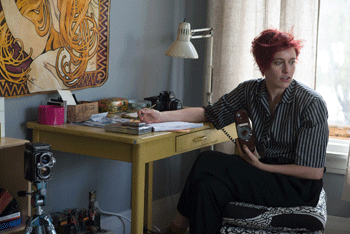 The Community Of 20th Century Women
The Community Of 20th Century Women
'This is the really hard part. And then what happens is, there's a hard part but then it gets better. Then it gets hard again."
To fully develop the film's palpably genuine ambience, Mike Mills challenged his cast in a variety of ways. While Mills' style has a patch-worked postmodern sensibility, he likes a handmade feel, especially for this film, which draws on the DIY punk aesthetic. He is a fan of shooting in straight-ahead chronological order and equally of old fashioned intensive rehearsal, building the foundation for his intimate storytelling out of ephemeral connections – connections from actor to actor and between actor's lives and story themes – before bringing cameras into the proceedings. So he assembled the cast of 20th Century Women two weeks before shooting and threw them into a series of games, exercises and Q&A sessions. 'I like to create a very enriched kind of atmosphere," Mills says. Mills broke the ice between the actors in many ways specific to the story: there were field trips to Santa Barbara and daily dance parties in which each cast member brought a piece of music related to their character. Annette Bening would bring 30s and 40s classics; Greta Gerwig brought in the Talking Heads and Bowie; Billy Crudup brought in folk songs; Elle Fanning brought in Fleetwood Mac; and Lucas Zumann brought in an array of punk he was just discovering. No matter what the song or style, everyone danced. 'The dancing you see in the film really came out of that," says Mills. 'It became a way of connecting everyone and it was clear that something vital happened when they danced."
Says Greta Gerwig: 'There's nothing more embarrassing really than dancing in broad daylight with five total strangers; and yet in doing that so early on made us comfortable with each other. It was a fast path to feeling completely safe."
Throughout the rehearsals, the cast drew from Mills, knowing how personal the story was to him. 'Everything started with Mike's generosity," Crudup says. 'He would share his stories with us and he would talk about the film in such a sophisticated and loving way that we all became deeply invested collectively in telling the story the way he saw and understood it." Adds Gerwig: 'Mike cast a spell over everyone. He is one of the kindest and most sensitive directors I've ever worked with – he would sometimes even cry behind the monitor because he cared so much about these people. I've never worked with a director like that. I really felt I learned about a different way to direct. He truly honours each person's sanctity.
And he was always playing music. On some days, he would have a cello player perform while they were doing these complicated set-ups for the tracking shots. It always felt he was creating a happening and the movie was coming out of that happening. But as much as that can seem random, it takes extraordinary discipline and skill to pull off."
Sums up Annette Bening: 'The atmosphere Mike creates makes you want to give everything you can to serve the larger ideas he is after. He's such a beautiful, openhearted man and I think that quality especially permeates this film. He's very gentle but within that gentleness there is a fiercely tenacious artist who has a lot to say. His life, his thoughts and his taste are at the centre of this film. Nothing was left to chance until everyone was in the room and the camera was on. That's when things got really exciting, and that's the unknown part that Mike trusts. It's that thing you can't name and you can't quantify, but it ends up being what hits people in their gut."
20th Century Women
Release Date: June 1st, 2017
Have You Seen This?
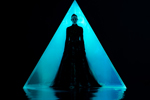
Elle Fanning The Neon Demon
When aspiring model Jesse moves to Los Angeles, her youth and vitality are devoured by a group of...
MORE
- Mission: Impossible Fallout
- Glenn Close The Wife
- Allison Chhorn Stanley's Mouth Interview
- Benicio Del Toro Sicario: Day of the Soldado
- Dame Judi Dench Tea With The Dames
- Sandra Bullock Ocean's 8
- Chris Pratt Jurassic World: Fallen Kingdom
- Claudia Sangiorgi Dalimore and Michelle Grace...
- Rachel McAdams Disobedience Interview
- Sebastián Lelio and Alessandro Nivola...
- Perri Cummings Trench Interview

